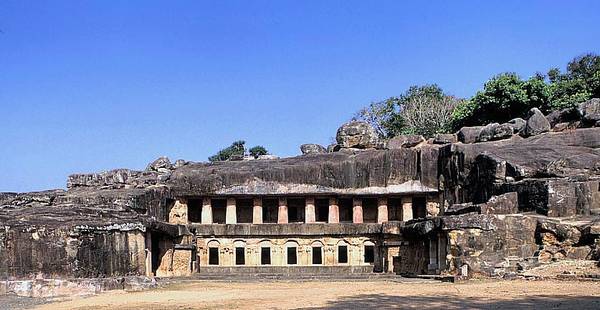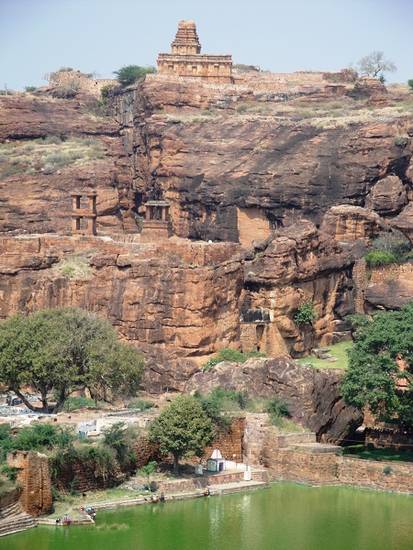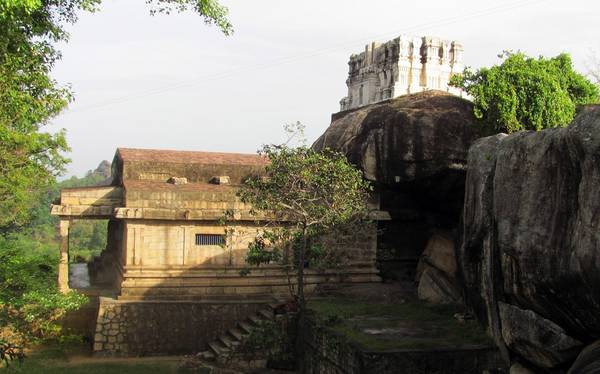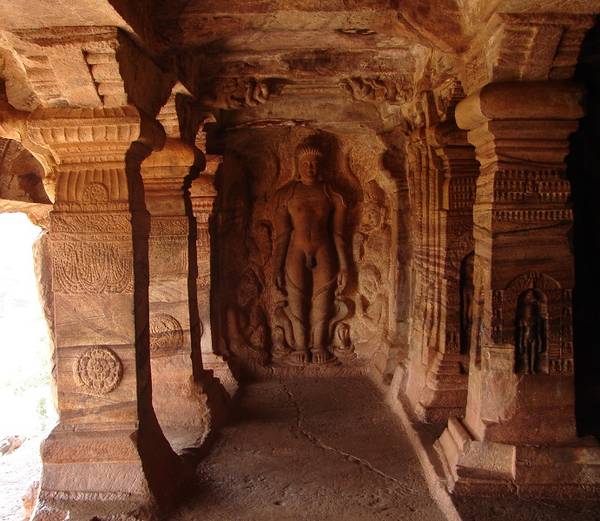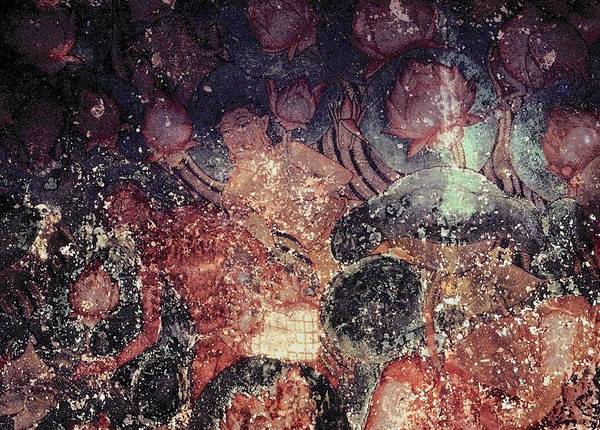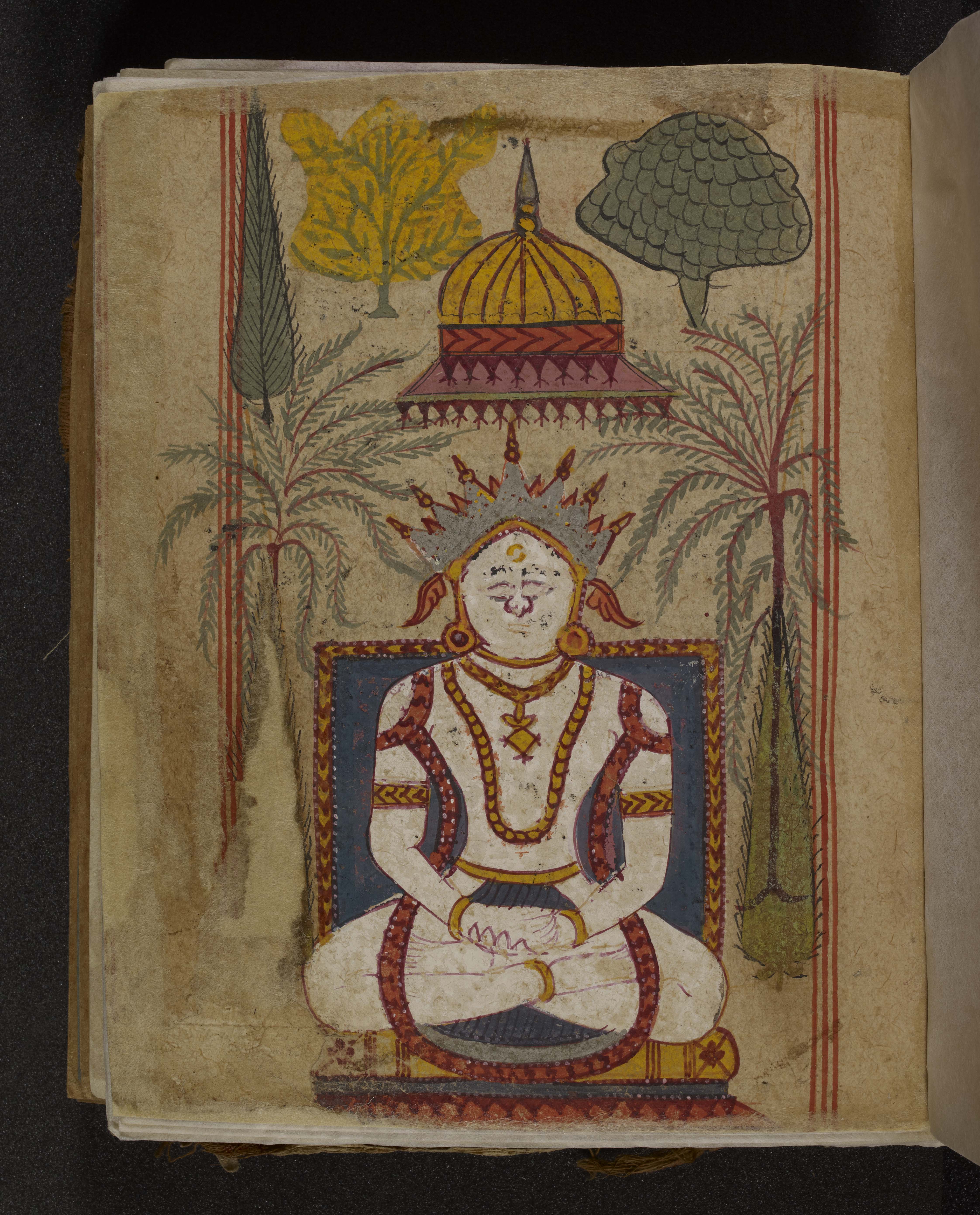Article: Cave temples
Jain temple caves are found throughout the Indian subcontinent and are among the earliest surviving architectural remains of the Jain religion. The variety of names for a place of Jain religious activity comes from the many different uses of the early cave temples, such as religious ritual, ascetic dwelling place or religious school.
Initially, the Jains used natural caves. Without modifications or inscriptions, however, the earliest phase of Jain cave temples is often difficult to date. While the early caves seem to have been used only as ascetic dwellings, later on religious images were often carved out of the natural rock. These caves then became shrines dedicated to the Jinas and their attendants. Enlargements and additions in wood or other materials have also frequently been added to the front of caves.
Despite the rise of dedicated temples built of stone from about the sixth century, cave temples have been used throughout Jain history. Many artificial caves have also been created, up to the present day. Frequently associated with religious and legendary figures, cave temples are often important pilgrimage destinations. Cave temples are still popular today even though there are several types of Jain temple architecture in India.
Development of cave temples
Some of the earliest dated Jain caves in the north-west of India are the monastic Bāvā-Pyārā Caves near Junagadh in Gujarat. Cut out of the rock, these caves have been firmly linked to Jain activities from the first centuries of the Common Era.
Predating these are the Jain caves at Khanda-giri and Udaya-giri in Orissa, which are among the earliest Jain remains on the east coast of India. King Khāravela’s inscription in the Hāthī-gumphā stems from the second century BCE and indicates the early Jain occupation of this site.
In central India, a cave dedicated to Pārśvanātha or Lord Pārśva, the 23rd Jina, at Udaya-giri, near Vidisha, bears an inscription from the early fifth century CE.
In the south of the country, cave remains in Tamil Nadu and Kerala date from as early as the second to first centuries BCE. Many early Jain caves in southern India were originally dwellings. During the seventh to ninth centuries CE they were altered and decorated, and stayed in continuous use until at least the 11th century.
Although temples built out of blocks of stone were introduced around the sixth to seventh centuries CE, the continued use of these caves shows that the Jains did not abandon their cave sites in favour of constructed temples.
Altering cave temples
From at least the seventh century, natural caves were often enlarged and entirely artificial ones created. Probably the best-known Jain cave, which is believed to be completely man-made, is the ninth-century cave overlooking the lake at Badami in Karnataka.
At other sites, cavities were extended into the natural rock at the back. One example is the large cave at Mammandur in Tamil Nadu.
Even during later periods, the Jain faithful continued to excavate cave sites. One instance is the Jain rock-cut temple at Tringalvadi near Nasik in Maharashtra, which was begun in the 14th century.
From about the ninth century, Jains also created positive architectural shapes by decorating the outside of huge boulders and carving away the surface of entire mountain ranges to create temple structures that are cut into the rock but not caves. The most prominent example is the monolithic temple at Ellora in Maharashtra, known as the Choṭā Kailāśa Temple or Jain cave number 20. It is smaller than the famous Hindu Kailāśanātha Temple – cave number 16 – at the same site, but it follows the same principle of creation.
Porches for cave temples
Porches were frequently added to the front of cave temples. There are examples of entire temple halls being raised in front, with the cave comprising only the sanctum – known as the garbha-gṛha.
Many caves had porches of wood or other less durable materials. Good examples can still be seen at Gwalior in Madhya Pradesh and at Kalugumalai in Tamil Nadu. Today, post holes carved into the terraces and facades of many caves are the only signs left of porches made of materials that have been destroyed over time.
In central India especially, many Jain cave temples had porches in stone. Examples can be seen at:
- Gajpantha in Maharashtra
- the bottom of the twin peaks of Maṅgī and Tuṅgī, also in Maharashtra
- the cave at the bottom of the hill at Sittanavasal in Tamil Nadu.
Decorations of cave temples
Numerous cave temples boast religious art. Many house sacred objects of worship, ranging from simple foot imprints of the Jinas and other saintly teachers to highly elaborate statues, often with inscriptions.
Most images have been carved out of the cave wall either in relief or, more rarely, as free-standing figures. Examples of painted or tiled interiors of cave temples sometimes occur. Icons are also found on rocks and cliff faces outside cave temples, especially in southern India.
Icons inside cave temples
Many earlier caves have been greatly altered and adorned with carved Jain icons. Such representations can be very simple, almost giving the impression of an aniconic veneration of the sacred ground of the caves. Other depictions are more clearly figural and include images of the 24 Jinas as well as their yakṣas, yakṣīs and other attendants.
In most cases, the statues have been carved out of the natural rock of the caves, as is the case at Khanda-giri in Orissa and at a Jain site of the same name near Canderi in Uttar Pradesh. The images have often been combined with inscriptions, illustrated by the Sonbhaṇḍār Caves at Rajgir in Bihar.
In other cases, loose sculptural representations have been set into niches in the walls of caves. These may be plaques of reliefs but are usually free-standing statues of just one figure or of one flanked by attendants. Although this is relatively rare, examples can be seen in the cave at Gajpantha in Maharashtra.
Other decorations inside cave temples
Some caves, such as those at Sittanavasal in Tamil Nadu and Ellora in Maharashtra, have elaborately painted ceilings. In addition, the pillars and certain statues inside still bear remains of coloured pigments.
From about the 16th century, ceramic tiles were also used to adorn earlier caves, such as those surrounding the twin peaks of Maṅgī and Tuṅgī in Maharashtra.
Icons outside cave temples
A tradition of creating Jain icons outside cave temples was particularly popular in the south of India. Many images have been carved on boulders and rocky cliffs. Boulder carvings can be seen at Tirakkol in Tamil Nadu while figures carved in the rock face are found at:
- Śravaṇa Beḷgoḷa in Karnataka
- Chitral in modern-day Pakistan
- Raya Durg in Andhra Pradesh.
Religious importance of cave temples
In South Asia, mountains are generally regarded as hallowed places. In Jainism, hills and mountain peaks have regularly been linked with the enlightenment of Jinas and other important teachers and personalities. In Jain caves, the religious importance of hills is coupled with the sacredness of holy ground. Natural caves are regarded as self-created divine places, and even those which have been made by hand are considered to be spaces removed from the routines of worldly life.
As well as these religious connotations, caves have a comfortable, balanced climate. They are cool in the summer months and warm during the cold winter period. These reasons account for the continued importance of cave sites throughout India.
The religious importance of caves as retreats and meditation places for Jain ascetics is still strong in the present day. Countless Jain caverns are pilgrimage sites and it is noteworthy that it usually is the legendary association with an important Jain personality and not the artistic beauty and complexity of such caves that underlie their popularity. Most ritually important cave sites have not been greatly altered architecturally, but are associated with the meditation and enlightenment of particular Jinas and Jain teachers. These caves are considered sacred because they are places of enlightenment – mokṣa-sthānas. Examples include the enlightenment cave of:
- the 12th Jina, Vāsupūjya, on Mandar Hill in Bihar
- Bhadrabāhu on Candra-giri at Śravaṇa Beḷgoḷa in Karnataka.
Other natural caves are not sacred by association, however, and are used today by both ascetics and lay people for temporary religious retreats, such as the meditation caves at Taranga in Gujarat and on Ponnur Hill in Tamil Nadu.
Reading
- ‘The Jaina Temple: Its Architecture, Associated Buildings and Ritual Accessories – 1. Cave Temples’
Julia A. B. Hegewald - Jaina Temple Architecture in India: The Development of a Distinct Language in Space and Ritual
Monographien zur indischen Archäologie, Kunst und Philologie series; volume 19
Stiftung Ernst Waldschmidt, G+H-Verlag; Berlin, Germany; 2009
Links
- Exterior of Ellora caves
-
This 2010 photograph on Flickr shows the entrance to one of the five Jain caves at Ellora, Maharashtra. The elephant is a symbol of royalty, which underlines the exalted spiritual rank of the Jinas and other holy figures depicted inside the cave temples.
- Entrance to Jain cave temple
-
The portico of one of the Jain cave temples at Ellora, Maharashtra, is captured in this 2008 photograph on Flickr. There are 34 cave temples at this site, but only five Jain temples. The Jain caves are noted for their fine carving and impressive sculpted figures of Jinas and other holy figures.
- Ellora caves
-
The Ellora Caves website is part of an academic project to document the 34 cave temples at Ellora, Maharashtra. Most of the caves at this World Heritage Site are Buddhist and Hindu caves, with five belonging to the Jain faith. The earliest Digambara caves have been dated to the ninth century. They are famous for their detailed sculptures.
- Interior of Jain caves at Ellora
-
This YouTube video uploaded in 2011 presents the Jain caves at Ellora, Maharashtra. The interiors of the five caves boast intricate carved pillars, detailed figures of Jinas and deities, and the remnants of rich frescoes and bright colours.
- Historical image of the Indra Sabha cave
-
The British Library website provides a 19th-century zoomable photograph of the Jain cave temple in the Ellora cave complex, Maharashtra.
http://www.bl.uk/onlinegallery/onlineex/apac/photocoll/other/019pho000000040u00140000.html
- Kūṣmāṇḍinī at Ellora
-
A damaged figure of the yakṣī Kūṣmāṇḍinī or Ambikā beneath a mango tree in cave 32 of the Ellora temple complex in Maharashtra. Attended by servants, the Digambara statue wears an elaborate headdress and jewellery, and sits on her lion vehicle. Only half of the image of the small child sitting on her thigh has survived. This zoomable photograph is part of the Beyond the Taj: Architectural Traditions and Landscape Experience in South Asia project at Cornell University Library in the USA.
- Cave 32 at Ellora
-
The five Jain caves at Ellora, Maharashtra, feature very fine examples of sculpture on the pillars and the walls, with deep reliefs depicting Jinas and other holy figures. This figure from cave 32, known as the Indra Sabha cave, is of a Jina, presented in the Digambara style. He is naked and standing in deep meditation. He is probably the 23rd Jina Pārśva, although his snakehood canopy is damaged, as this 2012 Flickr photograph shows.
- Cakreśvarī at Ellora
-
The Ellora Caves project presents this photograph of an early Digambara figure of the goddess Cakreśvarī, found in cave 30 of the cave temples at Ellora, Maharashtra. The yakṣī of the first Jina, Ṛṣabhanātha or Lord Ṛṣabha, Cakreśvarī's power is symbolised in the weapon of the disc – cakra – from which she gets her name.
http://elloracaves.org/caves.php?cmd=search&words=&cave_ID=30&plan_floor=1&image_ID=2656
- Vallimalai cave entrance
-
This 2006 photograph on Flickr captures the opening to the Jain cave temple in Vallamalai in Tamil Nadu. Caves may have been the first Jain religious places but have remained popular for meditation and worship ever since the early ones, created long before the Common Era.
- Vallamalai rock-cut figures
-
This 2006 photograph on Flickr shows some of the rock-cut sculptures in the Jain cave in Vallamalai, Tamil Nadu. Most of the figures represent the 24 Jinas but there are also statues of other holy figures. One example is the yakśī Padmāvatī, who is on the bottom right, holding the ankuśa, a noose, a lotus and a fruit in her four hands. She is a very popular goddess who is worshipped in her own right, especially in southern India.
- Vallimalai reliefs
-
Rock-cut figures of Jinas inside the Jain cave temple at Vallimalai in Tamil Nadu. The sculptures probably date from the ninth century. This 2005 photograph is provided by Flickr.
- Thirumalai cave
-
This 2011 YouTube video explores the cave temple at Thirumalai, near Arni in Tamil Nadu. The temple contain statues and inscriptions on rocks.
- Sittannavasal cave temple
-
The Archaeological Survey of India supplies historical and practical information about the rock-cut temple at Sittannavasal in Tamil Nadu.
- Sittanavasal temple
-
The HereNow4U website provides information about the Digambara site of Sittanavasal in Tamil Nadu. Famous for its colourful frescoes, the cave temple is also listed by the Archaeological Survey of India as a protected monument.
- Kalugumalai sculptures
-
This 2012 YouTube video explores the cave temple at Kalugumalai in Tamil Nadu, which boasts striking examples of rock-cut sculptures of Jinas as well as a cave temple. Over one hundred figures are carved into the cliff face outside the cave temple, nearly all of whom are Jinas, who mostly sit in meditation. There are numerous other stone statues at the site.
- Badami Jain cave temple
-
This photograph on Flickr shows the exterior of the Jain cave temple at Badami in Karnataka. It is the only Jain temple of the four caves at the site, and may date back to the eighth century.
- Jain cave at Badami
-
This 2010 YouTube video shows the interior of the Jain cave temple at Badami in Karnataka, with details of the images of Jinas and deities.
- Bāhubali in Badami cave temple
-
Figure of the great Jain saint Bāhubali inside the Jain cave at Badami, northern Karnataka. The vines and creepers twining up his legs while he is deep in meditation are clearly visible. He is surrounded by attendants. Images of meditating Jinas are also set into niches in some of the ornately carved pillars within the cave.
- Bhubaneshvar caves
-
This 2010 YouTube video briefly explores presents the Jain caves at Bhubaneshvar, the capital of Orissa state. Found on top of the twin hills known as Udaya-giri and Khanda-giri, the temples house wall reliefs and sculptures.
- +
- aAbhavya
- aAbhinandana
- aAbhiṣeka
- aĀcāra
- aĀcārāṅga-sūtra
- aĀcārya
- aAchalbhrata
- aAḍhāī-dvīpa
- aAdharma
- aAdho-loka
- aAdhyayana
- aAdvaita Vedānta
- aĀgama
- aAghātīya
- aAghātīya-karman
- aAgnibhuti
- aAgra
- aĀhāra
- aAhiṃsā
- aAhimsa Day
- aAjita
- aAjīva
- aAkampit
- aĀkāśa
- aAkbar the Great
- aAkṣaya-tṛtīyā
- aAlauddin Khalji
- aAlbert Einstein
- aAllah
- aAlms
- aĀlocanā
- aAloka-ākāśa
- aAmāri
- aAmbikā or Kūṣmāṇḍinī
- aAnagāra
- aAnanta
- aAnarthadaṇḍa
- aAnaśana
- aAnekānta-vāda
- aAṅga
- aAniconism
- aAnojjā
- aAntarāla
- aAntarāya-karma
- aAṇu
- aAṇu-vrata
- aAnukampā
- aAnuprekṣā
- aAnusvāra
- aApabhraṃśa
- aAparigraha
- aAra
- aĀrambha
- aĀrambhaja
- aĀratī
- aArdhamāgadhī Prākrit
- aArhaṃ
- aArhat
- aArśana-āvaraṇīya-karma
- aĀrta-dhyāna
- aĀryikā
- aĀryikā Jñānamati
- aĀśātanā
- aĀścarya
- aAscetic
- aAsceticism
- aAshram
- aAspiration
- aĀsrava
- aAṣṭa-maṅgala
- aAṣṭāpada
- aAstikāya
- aAstrolabe
- aAsura
- aAtheism
- aAticāra
- aAtiśayakṣetra
- aAtithisaṃvibhāgavrata
- aĀtma-vāda
- aĀtman
- aAuṃ
- aAurangzeb
- aAuspicious
- aAusterity
- aAvadhāna
- aAvadhi-jñāna
- aĀvaraṇī-yakarman
- aAvasarpiṇī
- aAvatāra
- aAvidyā
- aAxiom
- aĀyāga-paṭa
- aĀyambil
- aĀyu-karma
- aĀyurveda
- bBabur
- bBāhubali
- bBaladeva
- bBālāvabodha
- bBandha
- bBasadi
- bBazaar
- bBhadrankarvijay
- bBhagavant
- bBhaktāmara-stotra
- bBhakti
- bBhale
- bBharata
- bBhāṣā
- bBhāṣya
- bBhaṭṭāraka
- bBhāva
- bBhāva-pūjā
- bBhāvanā
- bBhavana-vāsin
- bBhavya
- bBhavyatva
- bBhaya
- bBhoga-bhūmi
- bBhogopabhoga
- bBodhi
- bBollywood
- bBrahmā
- bBrahma-deva
- bBrahmacārī
- bBrāhmaṇa
- bBraj Bhāṣā
- bBright fortnight
- bBritish Raj
- bBuddha
- bBuddhi-sagar
- bBuddhism
- bBuddhist
- cCaitya
- cCaityavāsin
- cCakravartin
- cCakreśvarī
- cCāmara
- cCandanā
- cCandragupta
- cCandraprabha
- cCanon
- cCāritra
- cCāritramohanīya-karman
- cCarũrī
- cCaste
- cCaturvidha-saṅgha
- cCaturviṃśati-stava
- cCāturyāma
- cCE
- cCelibacy
- cCha
- cChadmastha
- cChastity
- cCheda-sūtra
- cChristian
- cChristianity
- cClergy
- cCloning
- cColophon
- cCommentary
- cConch
- cConfession
- cCongregation
- cConsecration
- cCosmology
- cCremation
- cCrore
- cCult
- cCūrṇi
- dDādā-guru
- dDalit
- dDāna
- dDaṇḍa
- dDark fortnight
- dDarśana
- dDarśanamohanī-yakarman
- dDaśa-lakṣaṇa-parvan
- dDeity
- dDelhi Sultanate
- dDerāsar
- dDeśāvakāśika-vrata
- dDetachment
- dDevanāgarī
- dDevānandā
- dDevarddhi-gani
- dDevotee
- dDhamal
- dDhanuṣ
- dDhāra
- dDharma
- dDharma-dhyāna
- dDharma-sāgara
- dDharmastikaya
- dDhātakīkhaṇḍa
- dDholak
- dDhyāna
- dDiaspora
- dDig-vrata
- dDigambara
- dDīkṣā
- dDisciple
- dDīvālī
- dDivya-dhvani
- dDNA
- dDoctrine
- dDogma
- dDonor
- dDoṣa
- dDravya
- dDravya-pūjā
- dDrone
- dDuṣamā
- dDuṣamā-duṣamā
- dDuṣamā-suṣamā
- dDveṣa
- dDvīpa
- eEast India Company
- eEightfold Path
- eEkānta-vāda
- eEkendriya
- eElder
- eElders
- eEschatology
- eEtc up to
- fFarmān
- fFast
- fFatehpur Sikri
- fFestival
- fFestschrift
- fFiruz Shah
- fFly-Whisks
- fFolio
- fFour Noble Truths
- gGaccha
- gGaṇa
- gGaṇadhara
- gGanadharavada
- gGaṇeśa
- gGaṇin
- gGarba
- gGarbha
- gGarbha-gṛha
- gGaruḍa
- gGati
- gGene
- gGenomics
- gGhātī-yakarman
- gGhātīya
- gGhaznavid
- gGhiyasuddin Tughlaq
- gGhurid
- gGloss
- gGotra-karma
- gGujarāt
- gGujarati
- gGuṇa
- gGuṇa-sthāna
- gGuṇa-vrata
- gGupti
- gGuru
- gGuruṇī
- hHagiography
- hHajj
- hHaṃsa
- hHaribhadra
- hHariṇaigameṣin
- hHasta
- hHeresy
- hHiṃsā
- hHindi
- hHindu
- hHinduism
- hHīravijaya
- hHoroscope
- hHrīṃ
- hHumayun
- hHymn
- iIconoclasm
- iIconography
- iIdol
- iIndian Independence
- iIndology
- iIndra
- iIndrabhūti Gautama
- iIndriya
- iInitiation
- iIntercession
- iInvocation
- iIQ
- iIslam
- iIslamicate
- iIṣṭadevatā
- iĪśvara
- jJagat
- jJahangir
- jJain
- jJaina Devanāgarī
- jJaina Śaurasenī
- jJaina-dharma
- jJainaśāsana
- jJainness
- jJaisalmer
- jJamāli
- jJambū-dvīpa
- jJames Burgess
- jJanma
- jJanma-kalyāṇa
- jJarā
- jJāti
- jJina
- jJina-āgama
- jJina-bhavana
- jJina-bimba
- jJina-mātā
- jJinacandra-sūri
- jJinadatta
- jJinaprabha
- jJīva
- jJñāna
- jJñāna-āvaraṇīya-karma
- jJñāna-āvarṇiya
- jJñānsundar
- jJyotiṣka
- kKāla
- kKālakācārya-kathā
- kKālidāsa
- kKalpa-sūtra
- kKalpa-vṛkṣa
- kKalyāṇaka
- kKalyanvijay
- kKamaṇḍalu
- kKamaṭha
- kKarma
- kKarma-bhūmi
- kKarma-grantha
- kKarma-prakṛti
- kKarma-vāda
- kKarmon
- kKarnataka
- kKaṣāya
- kKathā
- kKāvya
- kKāya
- kKāyotsarga
- kKeśa-loca
- kKetu
- kKevala-jñāna
- kKevalin
- kKhalji
- kKharatara-gaccha
- kKnowledge
- kKriyā
- kKriyā-vāda
- kKṛṣṇa
- kKṣamā-śramaṇa
- kKṣapakaśreṇi
- kKṣatriya
- kKṣullaka
- kKulakara
- kKundakunda
- kKunthu
- lLabdhi
- lLaity
- lLakh
- lLāñchana
- lLands of Action
- lLaukāntika
- lLavaṇa-samudra
- lLeśyā
- lLiṅga
- lLinguistics
- lLoka
- lLoka-ākāśa
- lLoka-puruṣa
- lLoka-vāda
- lLotus
- lLotus lake
- mMadhya-loka
- mMahā-videha
- mMahā-vrata
- mMahābhārata
- mMahāmastakābhiṣeka
- mMāhārāṣṭra
- mMāhārāṣṭrī Prākrit
- mMahattarā Yākinī
- mMahāvīr Jayantī
- mMahāvīra
- mMakāra
- mMakkhali Gośāla
- mMalli
- mMāna-stambha
- mManaḥ-paryāya-jñāna
- mMaṇḍala
- mMaṇḍapa
- mMandit
- mMaṅgala
- mMantra
- mMantras
- mManuṣya-loka
- mMarāṭhī
- mMārgaṇā
- mMartyr
- mMarudevī
- mMaṭha
- mMati-jñāna
- mMauryaputra
- mMecca
- mMendicant lineage
- mMetarya
- mMiracle
- mMithyādṛṣṭi
- mMohandas Gandhi
- mMohanīya-karma
- mMokṣa
- mMonastic order
- mMonasticism
- mMonk
- mMonotheism
- mMosque
- mMount Meru
- mMount Sammeta
- mMṛgāvatī
- mMughal
- mMuhammad
- mMuhammad bin Tughlaq
- mMuhpattī
- mMūla-sūtra
- mMūlaguṇa
- mMumbaī
- mMuni
- mMunisuvrata
- mMurad Bakhsh
- mMūrti-pūjaka
- mMuslim
- mMysticism
- nNābhi
- nNāga-kal
- nNāgapurīya Tapā-gaccha
- nNāgarī
- nNāma-karma
- nNamaskāra-mantra
- nNami
- nNandīśvara-dvīpa
- nNandivardhana
- nNandyāvarta
- nNāraka
- nNāraki
- nNasalisation
- nNātha
- nNavrātrī
- nNaya-vāda
- nNemi
- nNidāna
- nniggaṃthāṇa vā 2
- nniggaṃtho vā 2
- nNigoda
- nNihnava
- nNikṣepa
- nNirgrantha
- nNirjarā
- nNirvāṇa
- nNiryukti
- nNiṣidhi
- nNitya
- nNiyati
- nNo-kaṣāya
- nNudity
- nNun
- oOcean of milk
- oOmniscience
- oOrdination
- ppa°
- pPadmaprabha
- pPadmāsana
- pPadmāvatī
- pPādukā
- pPalanquin
- pPalette
- pPañca-muṣṭi
- pPāṇḍava
- pPaṇḍit
- pPandit Dalsukh D. Malvania
- pPandit Sukhlalji
- pPāṇipātra
- pPāpa
- pParamātman
- pParameṣṭhin
- pPāraṇā
- pParigraha
- pPariṇāma
- pParīṣaha
- pParokṣa
- pPārśva
- pPārśvanātha
- pParyāya
- pParyuṣaṇ
- pPaṭa
- pPatan
- pPātra
- pPenance
- pPersian
- pPhala
- pPhilology
- pPicchikā
- pPilgrimage
- pPīr
- pPolymath
- pPoṣadha
- pPossession
- pPothī
- pPrabhas
- pPradakṣiṇā
- pPradeśa
- pPrākāra
- pPrakīrṇaka-sūtra
- pPrākrit
- pPramāda
- pPramukhā
- pPrati-vāsudeva
- pPratikramaṇa
- pPratimā
- pPratiṣṭhā
- pPratyākhyāna
- pPratyakṣa
- pPravacana
- pPrāyaścitta
- pPrayer
- pPre-modern
- pPreach
- pPredestination
- pProtestant
- pProvenance
- pPudgala
- pPūjā
- pPujārī
- pPukharavara-dvīpa
- pPuṇya
- pPūrva
- pPuṣkara-dvīpa
- pPuṣpadanta
- pPyre
- qQur’an
- rRāga
- rRāhu
- rRainy season
- rRajasthan
- rRajasthani
- rRājimatī
- rRajoharaṇa
- rRajput
- rRāma
- rRāmāyaṇa
- rRangoli
- rRās-garbā
- rRasa
- rRathanemi
- rRatna-traya
- rRātri-bhojana
- rRaudra-dhyāna
- rRecto
- rRelic
- rRenunciation
- rRetroflex
- rRevatī
- %Ṛg-veda
- rRite
- rRosary
- %Ṛṣabha
- %Ṛṣabhanātha
- rRupee
- sSaciyā Mātā
- sSādhu
- sSādhvī
- sSāgāra
- sSaint
- sŚaivaism
- sŚaka-saṃvat
- sSallekhanā
- sŚalya
- sSamacatuṣṭha
- sSamādhimaraṇa
- sSamaṇi
- sSāmarambha
- sSamavasaraṇa
- sSāmāyika
- sSaṃbhava
- sSamiti
- sSaṃjñā
- sSaṃkalpaja
- sSaṃsāra
- sSamudghāta
- sSaṃvara
- sSaṃvega
- sSamyak-cāritra
- sSamyak-darśana
- sSamyak-jñāna
- sSamyaktva
- sSaṃyama
- sSanctuary
- sSandalwood
- sSaṇgha
- sSanskrit
- sSant
- sŚānti
- sSapta-bhaṅgi-naya
- sSārambha
- sSarasvatī
- sSarvajña
- sSāsan-devi
- sŚāsana-devatā
- sŚāstra
- %Ṣaṭ-jīvanikāya
- sSatī
- sSatīmātā
- sSatya
- sSchism
- sScribe
- sScripture
- sSect
- sSecularism
- sŚenāī
- sSermon
- sŚeṣavatī
- sSevā
- sSeven fields of donation
- sShah Jahan
- sShantidas Jhaveri
- sShrine
- sSiddha
- sSiddha-śilā
- sSiddhacakra or Navadevatā
- sSiddhānta
- sSiddhārtha
- sSiddhi
- sSikh
- sSikhism
- sŚikṣā-vrata
- sŚīla
- sSin
- sSindh
- sŚītala
- sŚiva
- sSkandha
- sSomanatha
- sŚraddhā
- sŚramaṇa
- sŚrāvaka
- sŚrāvakācāra
- sŚrāvikā
- sŚreyāṃsa
- sŚrī
- sŚrīvatsa
- sŚruta-jñāna
- sŚruta-pañcamī
- sSthānaka-vāsin
- sSthāpanācārya
- sSthāvara
- sSthavira
- sSthiti
- sStrīmukti
- sStūpa
- sSubcontinent
- sSudarshana
- sŚuddhi
- sSudharma
- sŚūdra
- sSufism
- sSukha
- sŚukla-dhyāna
- sSulasā
- sSultan
- sSumati
- sSundarśrī
- sSupārśva
- sSūri
- sSuṣamā
- sSuṣamā-duṣamā
- sSuṣamā-suṣamā
- sSūtra
- sSuyam me ausam! Tenam bhagavaya evamakkhayam
- sSvādhyāya
- sSvāhā
- sSvastika
- sŚvetāmbara
- sŚvetāmbara Terāpanthin
- sŚvetāmbaras
- sSwan
- sSyād-vāda
- tTabla
- tTantra
- tTapā-gaccha
- tTapas
- tTāraṇ Svāmī Panth
- tTattva
- tTattvārtha-sūtra
- tTemple
- tTemple-city
- tThe Enlightenment
- tTheology
- tThree worlds
- %Ṭīkā
- tTilaka
- tTīrtha
- tTīrthaṃkaranāma-karman
- tTīrthankara
- tTransliteration
- tTrasa
- tTrasa-nāḍī
- tTriśalā
- tTriṣaṣṭi-śalākā-puruṣa-caritra
- tTti bemi
- tTughlaq
- tTunk
- uUdumbara
- uUniversal History
- uUpādhyāya
- uUpāṅga
- uUpaniṣads
- uUpāsaka
- uUpasarga
- uUpāśraya
- uŪrdhva-loka
- uUtsarpiṇī
- uUttarādhyayana-sūtra
- vVāhana
- vVaimānika
- vVairāgya
- vVaiṣṇava
- vVaiśramaṇa
- vVaiśya
- vValabhī
- vVanaspatikāya
- vVandana
- vVaṇik
- vVarṇa
- vVāsudeva
- vVāsupūjya
- vVayubhūti
- vVeda
- vVedanīya-karma
- vVegetarianism
- vVehicle
- vVernacular
- vVerso
- vVidyā
- vVidyā-devī
- vVihāra
- vVijñapti-patra
- vVikrama-saṃvat
- vVikṛti
- vVimala
- vVinaya
- vVipāka
- vVirji Vora
- vVirodhaja
- vVīrya
- vVisarga
- vViṣṇu
- vVītarāga
- vVizier
- vVotive
- vVow
- vVrata
- vVS
- vVyakta
- vVyantara
- vVyasana
- yYakṣa
- yYakṣī
- yYantra
- yYaśoda
- yYaśovijaya
- yYati
- yYātrā
- yYoga
- yYoginī
- yYojana


